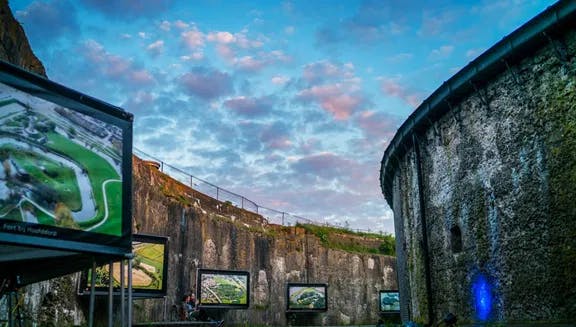
Art and culture in Weesp
City of Wesopa

Wandering past the City of Wesopa, you’ll likely stop for a second look. Far from the gabled canal houses that line most of Weesp’s streets, this towering theatre and cinema is an example of the late Amsterdam School architectural style and stands out because of it. Known as ‘The City’ by locals, it’s home to a diverse and alternative cultural programme, from spiky comedy nights to arthouse movies and even themed events (such as the Harry Potter walking tour of Weesp, where the city turns magical for a day). Head here after a day out on the water to round out your trip with something cultural.
Museum Weesp

Smack in the city centre is Museum Weesp. Housed on the top floor of the monumental town hall (from 1776), it’s one of the 100 most important monuments in the Netherlands. The collections will take you on a journey through the stories of the city and its inhabitants, from the earliest Iron Age settlement to the present day. Admire the first porcelain in the Netherlands, learn how chocolate is made and discover why the Weesper jenever was a favourite of the Dutch East India Company. For anyone interested in exploring the period rooms of this neoclassical building further, a one-hour audio tour is included in the entrance fee. And for the extra curious among us, the dungeons are still accessible to the public during museum opening hours. By appointment, the museum provides a unique tour during which all the secrets of the town hall are revealed.
Forts
If there’s one thing you won’t be lacking in Weesp, it’s forts. Both Fort Ossenmarkt and Uitermeer are the major reasons why Weesp is known as a fortress town, but both have slightly different histories and roles. Fort Ossenmarkt was built between 1859 and 1861 to close and defend the Vechtoevers, the locks and the Amsterdam-Amersfoort railway. Whether it was due to the enemy or the steely defence, like many forts, no shot was ever fired from it. The fort, which is now a UNESCO World Heritage site, is not open to the public, but it’s a visually stirring sight and a great starting point for a walk through Weesp. Better yet, if you’re not walking and you’ve got a bike or a boat, sail down to Fort Uitermeer – another part of the Dutch Defence Line – and be sure to stop at the waterfront restaurant, Porterhouse, nearby for a bite.
Molen de Vriendschap

A traditional windmill where ecological grains are still ground into flour using good old-fashioned wind power, Molen de Vriendschap serves up a suitable slice of Dutchness for visitors. Budding bakers and anyone who loves pastries, sourdough bread and gingerbread are welcome to pop into the windmill shop - open to the public every Saturday from 10:00 to 16:00.
Lock and Bridge Festival

The award for the most unusual festival goes to this one in Weesp, dubbed the Sluis-en-Bruggenfeest (the Lock and Bridge Festival). Created by the municipality in 1978, it commemorates the restoration of the locks and bridges in the city centre and has been celebrated yearly since its inception. With 220 stalls – of food, drink and goods – set up around Weesp, locals congregate on the streets, bridges and canals in the spirit of urban history, with plenty of festivities to go around. The event usually takes place on the last weekend in August.
Open Monument Day
During Open Monument Day in September, thousands of historic buildings and sites across the Netherlands are open to the public free of charge, with many locations also organising exhibitions, musical performances and guided tours. The municipality of Weesp often takes part; when Fort Ossenmarkt, a UNESCO World Heritage Site generally not open to the public, and the Molen De Vriendschap flour mill open their doors – a one-off opportunity to go behind the scenes at these uniquely Dutch heritage monuments.
Synagogue Weesp

Created by Jewish residents of Weesp towards the end of 1840, Synagogue Weesp has been an important community space up until today. But while the building has remained the same, it’s become something of a cultural centre for locals outside the faith, too, playing host to the annual 'Weespers aan de Wand' art event and countless exhibitions and concerts throughout the year.












